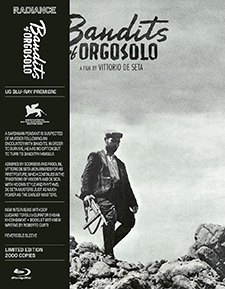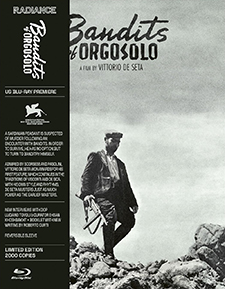Bandits of Orgosolo (Blu-ray Review)

Director
Vittorio De SetaRelease Date(s)
1960 (June 25, 2024)Studio(s)
Titanus (Radiance Films)- Film/Program Grade: A
- Video Grade: A
- Audio Grade: A
- Extras Grade: A-
Review
While, in the vaguest sense, Bandits of Orgosolo (Banditi a Orgosolo, 1960) is something like a Sardinian Bicycle Thieves, the director, co-writer, and co-cinematographer of the film is Vittorio De Seta, not Vittorio De Sica. Primarily a director of documentaries, De Seta (1923-2011) dabbled in narrative feature films (notably also the 1966 Almost a Man, with Jacques Perrin) and, later, television dramas, specializing in imaginative realism. Though many of his works were acclaimed in their time, it wasn’t until shortly before De Seta’s death that these works were rediscovered by cineastes.
Bandits of Orgosolo, his first narrative feature, is a revelation. In the Mediterranean island of Sardina (one of the 20 regions of Italy), a shepherd named Michele Jossu (Michele Cossu) watches over his flock of sheep in the remote mountains near Orgosolo, while training his teenage brother, Peppeddu (Peppeddu Cuccu), the ways of shepherding. A trio of pig rustlers stash their stolen pigs in Michele’s grazing area, hiding out from the police. When they arrive, one policeman is killed in a shoot-out with the bandits and the completely innocent Michele, who wanted nothing to do with the bandits, is implicated. Fearing arrest and long imprisonment, he flees with his flock high into the mountains of Barbagia. Though aided by his younger brother as well as relatives in a nearby village, Michele struggles to provide for his flock, exhausted from the constant movement, and lack of water and pasture.
De Seta uses no professional actors, and a crew of just three people including himself, relying on natural lighting throughout. Michele and Peppeddu Cossu were, apparently, real Sardinian shepherds as were all the other shepherds and villagers seen in the film. Everything the audience sees, therefore, is authentic and unfiltered: herding the flock, making cheese from their milk, setting a sheep’s broken leg, etc. is impressively naturalistic, and Michele Cossu especially has a great face for the camera and his circumspect performance could not have been bettered by a professional actor. In the Italian manner of the period everything was shot silent with the sparse dialogue (originally spoken in Sardinian) dubbed into Italian during post-production. Some viewers have complained about this, but the use of experienced voice actors works just fine—no less than Gian Maria Volonté, uncredited,dubs Michele Cossu. And, I would argue, it enhances the film, giving it just a bit of polish right where it needs it, plus it’s never intrusive or distracting. De Seta worked closely with his cast, incorporating incidents from their own lives and allowing them to, essentially, write their own dialogue.
Filmed in black-and-white for 1.37:1 standard projection, Bandits of Orgosolo is beautifully photographed throughout, capturing all the texture of the harsh landscapes while making the poor village seem ominous and threatening.
The picture is fascinating on several levels. The shepherds of present-day (i.e., 1960) Sardinia could be from the 18th or 19th century, so primitive are their lives, living in small shacks without electricity, running water, and using tools that probably haven’t changed much in 500 years. In this harsh environment they still barely subsist, Michele determined to keep his flock even while evading the police because he still owes money on them, he being the first generation of shepherds from his family not working under a feudal-type landowner. In the nearby village where the family resides, conditions aren’t much better, Michele’s family living in poverty, baking bread through the night to survive. This underlying theme is subtly expressed as are the prejudicial attitudes of the militaristic police, shepherds apparently residing near the bottom of the social ladder.
Radiance Films’ Region-Free Blu-ray of Bandits of Orgosolo offers a 4K restoration from the original camera negative, and one is hard-pressed to think of another 1.37:1 standard black-and-white film that looks better on Blu-ray. The uncompressed PCM mono audio is likewise excellent, supported by strong English subtitles.
Supplements consist of a new interview with cinematographer Luciano Tovoli (28 minutes); an interview with curator Ehsan Khoshbakht (11 minutes); a trailer, and a booklet featuring an excellent essay by Roberto Curti.
Bandits of Orgosolo is a film not to be missed. As accurately described by admirer Martin Scorsese, De Seta is “an anthropologist who spoke with the voice of a poet.”
- Stuart Galbraith IV

